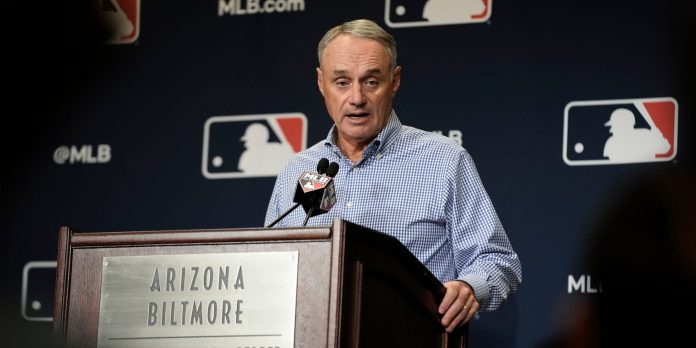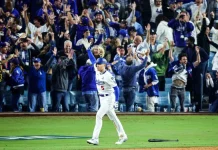Major League Baseball (MLB) Commissioner Rob Manfred is pushing for the Oakland Athletics’ move to Las Vegas to be completed. At the same time, he is watching closely the negotiations a sale for the Tampa Bay Rays and keeping the team in countries 11th largest media market. Ending the stadium deals for both the Athletics and the Rays will provide the league with the stability needed to secure a new national television contract when the current one expires in 2028.
Sports Talk Florida reported last month that Rob Manfred intends to adopt the NBA model that generated $76 billion for the league. This plan will commence this fall and continue through the 2035-2036 season. The deal involves three partners and includes an 11-year, $76 billion media rights agreement with Disney (ESPN/ABC), NBCUniversal, and Amazon.
Manfred believes he has more content than the NBA, and that MLB requires the global reach that basketball provides. He feels streaming can help achieve all of his media exposure he is looking for the league.
MUST READ
Manfred discussed the theory that MLB should emulate the NBA in securing a major media deal. The goal for MLB is to bring all local broadcasting under the league’s control. This approach aims to eliminate the issues caused by regional sports networks and shift the focus towards national games, ultimately increasing the value of MLB.
“Because of the changes in the media market, it’s clear we need to have a more national media strategy,” Manfred said, per Sports Business Journal. “And what that means is you’re going to generate more central revenue. When franchises get valued, the more central revenue you have, the higher multiple is applied to the revenues. And the reason for that is simple: [Potential buyers] see it as more predictable, as opposed to local things like ticket sales that go up and down. You make these 10-year deals, everybody knows you’re getting X in central money, and that increases the multiple that gets applied.”
According to Sports Business Journal, MLB team valuations range from 4 to 11 times a team’s implied revenue, while National Basketball Association (NBA) team valuations range from 10 to 15 times a team’s implied revenue. MLB Commissioner Rob Manfred believes this disparity is due to the NBA’s revenue being more centralized and shared equally among its teams. In contrast, MLB clubs depend more on local revenue sources, such as ticket sales and local media rights.
Currently, the New York Yankees are affiliated with the YES Network, the New York Mets with SNY, the Boston Red Sox with NESN, the Los Angeles Dodgers with Spectrum Cable, the Chicago Cubs with Marquee, and NBC Sports in the San Francisco Bay Area and Philadelphia. It’s important to note that the Dodgers are the only team whose network is not owned by the team, and they have a guaranteed deal.
Here is the MLB deal as it now it stands, Fox pays approximately $728 million for the rights to regular season games, playoffs, and the World Series. WBD, which includes TBS, truTV, and Max, pays around $535 million annually for its broadcast package. In 2022, Apple secured the rights to Friday Night Baseball doubleheaders for about $85 million per year. Roku’s MLB Sunday Leadoff package averages around $10 million per season.
One strong possibility that Manfred is exploring involves a combination of one or two linier networks FOX, NBC, and Warner Brothers-Discovery, which owners find appealing due to their familiarity with this approach. However, MLB has also embraced streaming opportunities with multiple streaming platforms like Apple, Amazon Prime, Netflix, Roku, and YouTube expressing interest in broadcasting MLB games. This move is aimed at capturing a rapidly expanding global streaming audience.
Manfield must secure a new media partner in the coming months, as it cannot afford to miss this opportunity. Reports indicate that the NFL is considering offering an international package of games, seeking over a billion dollars in rights fees—double what ESPN was paying for MLB rights. As rights fees continue to increase, MLB needs to ensure it maximizes the value of its product, even if that means partnering with multiple entities.







